As an Amazon Associate I earn from qualifying purchases.
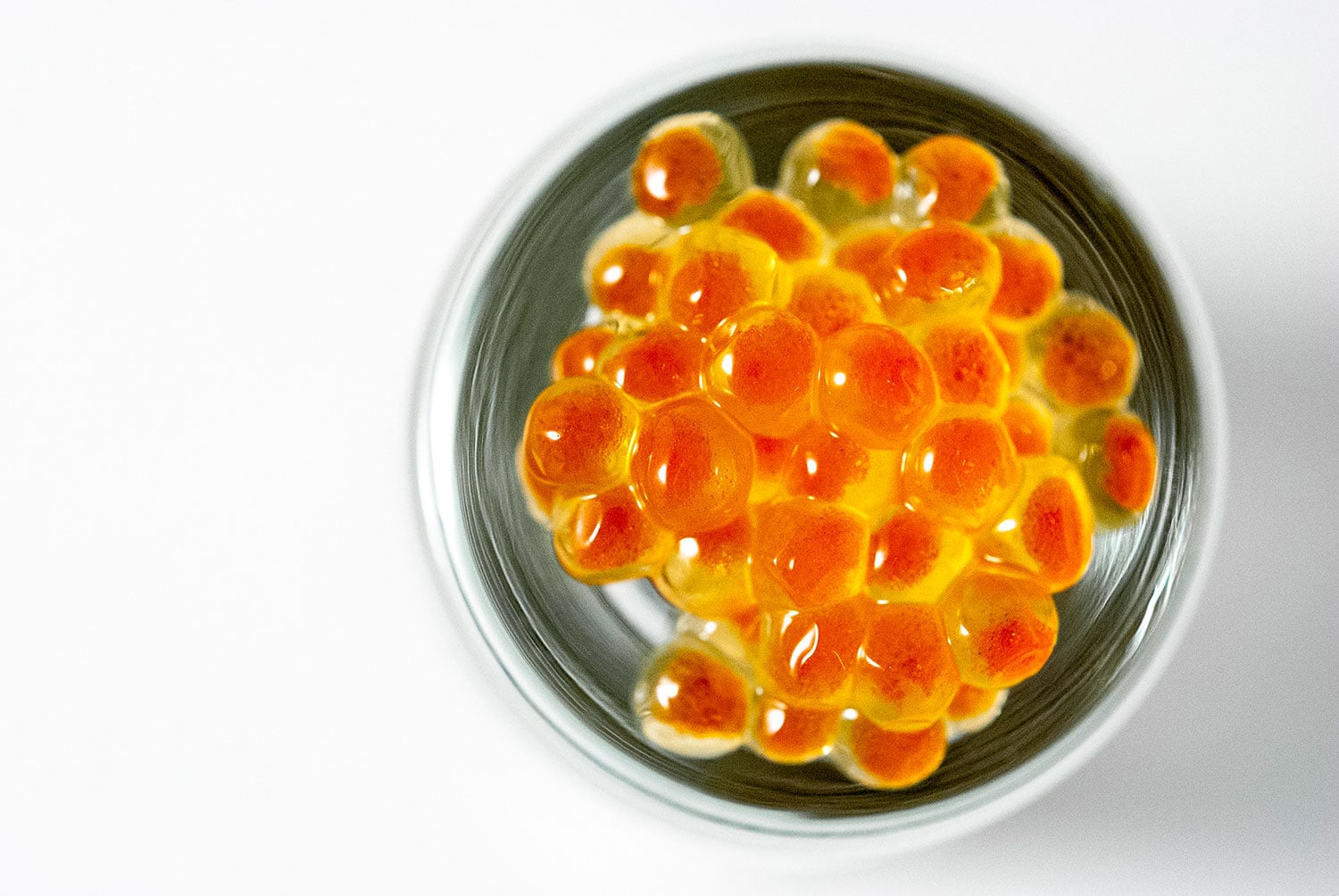
Caviar has always had a hold on me. It is a mysterious ingredient, almost otherworldy; the individual eggs look like jewels from an alien planet. Caviar tastes briny and vaguely floral, and the textural surprise of the pop in your mouth has led more than one writer to liken it to Pop Rocks for adults.
I’ve eaten all sorts of caviar, from spendy Osetra sturgeon caviar to our own California white sturgeon eggs, to Paddlefish roe to salmon roe ikura, to the wonderful little eggs from flying fish (tobiko), capelin and whitefish, which is a golden yellow. I’ve also eaten caviar from trout and char.
Steelhead roe is a particular favorite, as is king salmon roe.
I’d read about a general method of making caviar in a book called The Philosopher Fish, which involves gently removing the eggs from the skein — the membrane holding them together — rinsing them, salting them and drying them. It seemed pretty easy, which alarmed me: How could something so mysterious be so easy to create? It didn’t seem fair.
I delved into some more research, and it is indeed that easy. The art comes in the details: How do you get the eggs out of the skein? How much salt? How long to brine or rub the eggs? What temperature do you store them at?
So I use an amalgam of the methods I’d read about. I brine the salmon roe for a half hour in the fridge. Then I run the skein under hot tap water, which shrinks the membrane and lets the eggs drop into a colander. I then return the eggs to the brine for another 30 minutes. I rinse them off and let them drain in the colander for 15 minutes. Then I package them into a clean glass jar in the fridge. Done!
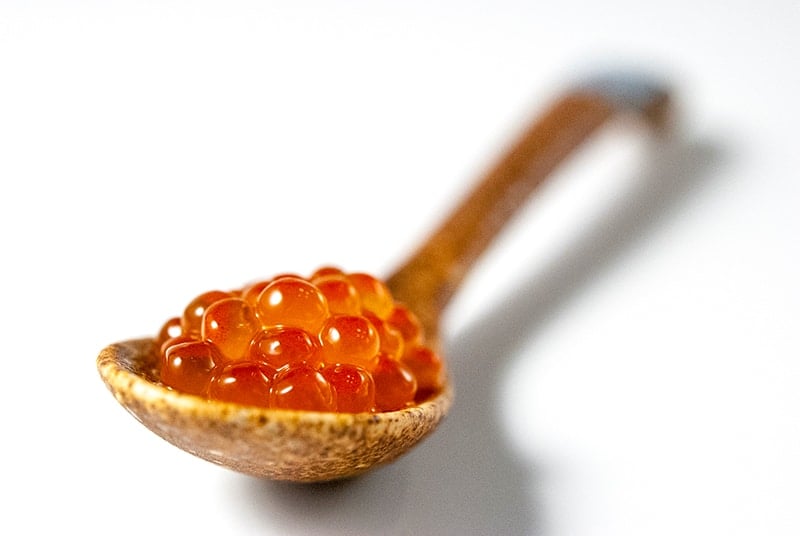
And there is an easier way: Run them over a cooling rack, membrane side up. Either method results in some egg loss, and the hot water trick can sometimes cook the eggs, which is no bueno.
Aren’t they the coolest things ever? I have a hard time not taking them out of the fridge just to look at them. homemade caviar keeps for 2 weeks in the fridge, but I think it gets fishy after about a week.
I prefer my caviar straight, served in a special spoon, so you can linger over the qualities of this caviar versus that one; this is what the Russians do when they serve the three classic sturgeon caviars: Beluga, Sevruga and Osetra. In case anyone cares, I am particularly fond of Osetra, which is pretty close to our caviar made from California white sturgeon.
Remove from your mind the notion that the only good caviar comes from sturgeon.
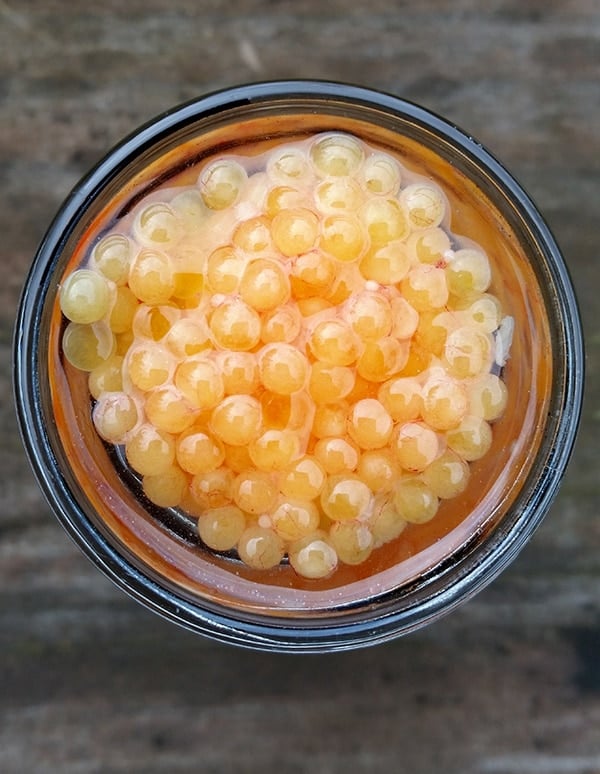
The tobiko and masago you see in sushi restaurants is caviar from the flying fish and the capelin, a kind of herring. It really is like pop rocks. Whitefish caviar is even better, and is a beautiful canary color. Lumpfish is like a larger sturgeon caviar, but trout and salmon caviar is its own thing: large, luxurious, and slightly fatty — I saw thousands of minute fat droplets floating on the top of the brine when I made it.
When combined with a larger dish, caviar can become an accent that makes a good dish great.
I make a pasta dish with flaked salmon, mixed with toasted pine nuts, parsley, shallots, olive oil, Meyer lemon juice — and a spoonful of salmon roe caviar. The color and pop really makes the dish.
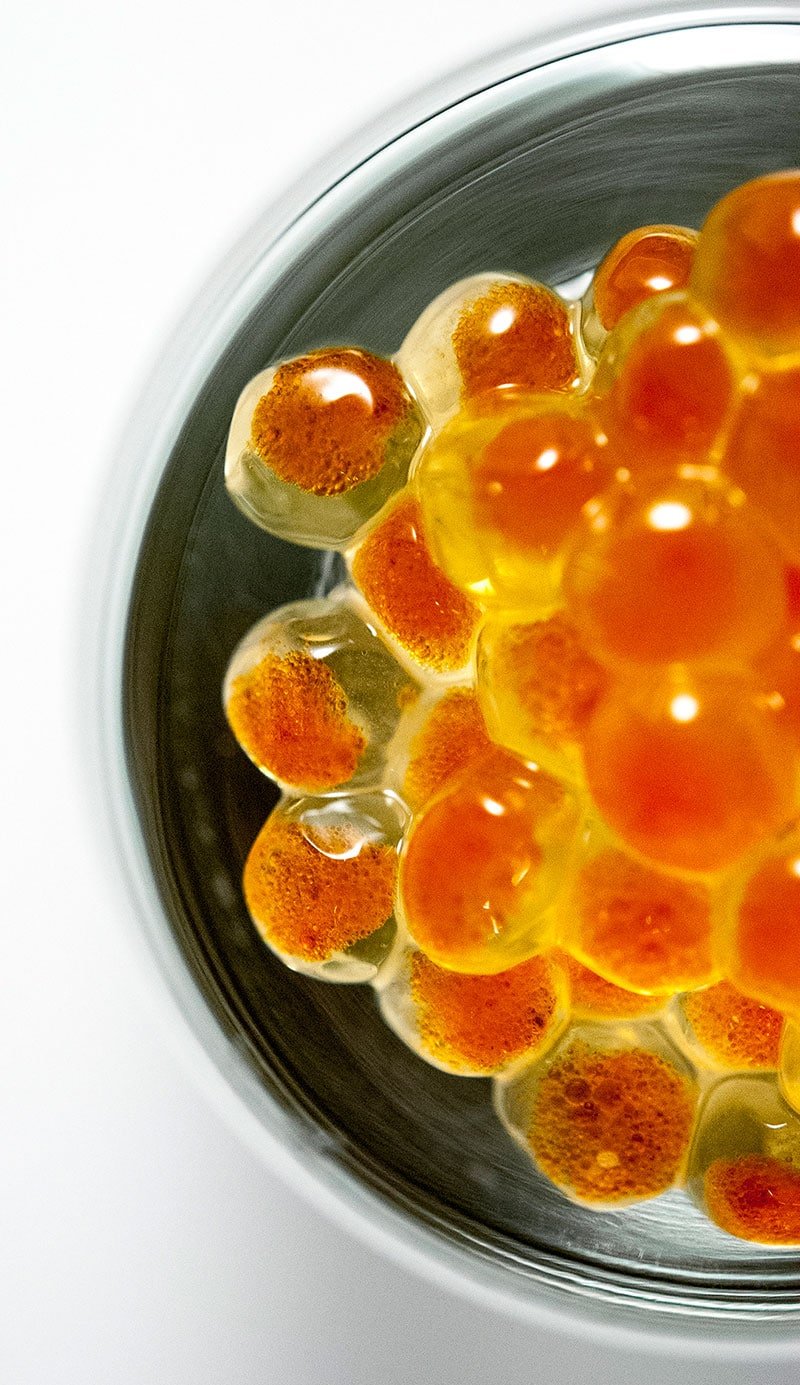
Homemade caviar also works well as a garnish for a simple Japanese dish of salmon or trout wrapped in buttered foil with some matsutake (or other) mushrooms, sake and lemon slices, then baked it for 20 minutes. Damn good.
Will this method work for other fish roes? Yep. I imagine the salting times and care you will need to dislodge the eggs will change, but the basic technique shouldn’t change.
How to Make Caviar
Ingredients
- 1 full skein of steelhead, trout or salmon roe
- 1/2 cup kosher salt
Instructions
- Mix the salt and 1 quart ice-cold water until the salt is all dissolved.
- Make sure the roe skeins are split, so you have an opening that the eggs can come out. Set up a cooling rack or something else with a wide mesh (chicken wire works, too) over a bowl. Take a roe skein and, with the membrane facing up work the eggs out through the rack. Perfectly ripe eggs will come off easily, unripe ones will require some force. Either way, you will pop some eggs in the process.
- ALTERNATE METHOD: Get the faucet running with warm water roughly 105°F to 115°F, or heat cool tap water to this temperature -- some people fear that hot tap water can add harsh minerals to their food. Either way works. Fill a metal or glass bowl with the warm water. Dunk a few skeins of roe at a time in the warm water. Gently massage the eggs out of the skeins with your fingers under the surface of the warm water. They will float away and sink. Discard the skeins.
- Have a fine-meshed sieve ready. Pour the strained eggs into the strainer to rinse them well with cold water. Pick out clumps or stray bits of membrane.
- Dunk the eggs in the brine for 5 minutes. Taste them and if they are salty enough for you, drain them again. You can brine for up to 30 minutes, but they will be very salty. My preferred brine time is 10 minutes. Spoon carefully into a clean glass jar and refrigerate for up to 2 weeks, but try to eat them within a week or they will start to get fishy.
Notes
Nutrition information is automatically calculated, so should only be used as an approximation.

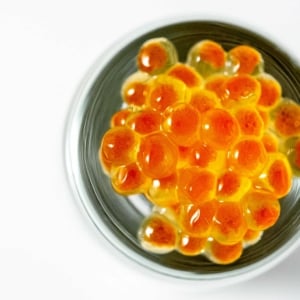

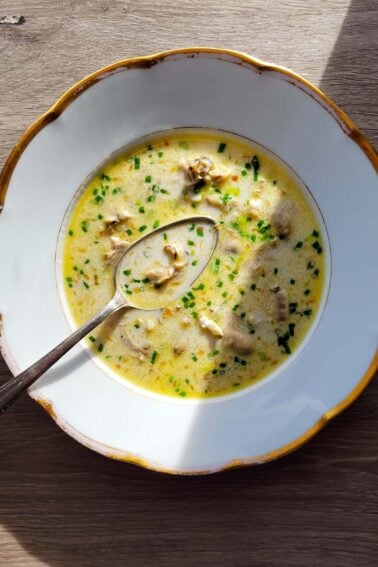

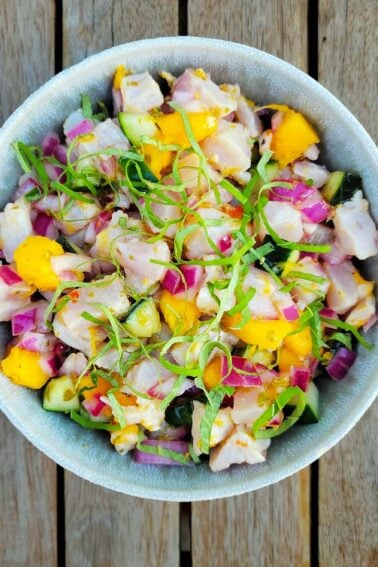
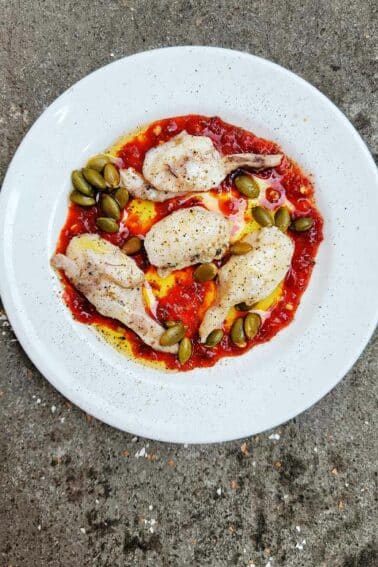
Has anyone tried making “caviar” with lionfish eggs? I’m organizing an invasive species cook-off and would love to include “caviar”. Please let me know.
I live in Cordova, Alaska, and eat Coho – Silver Salmon eggs as caviar all the time and love the little jewels,…I do mine a bit differently however and to a way I think that many of you will love. I start off with fresh skeins of roe, smoke them for 6 – 7 hrs in Alder (cold smoking only), then with warm water, 105 – 115F, separate the eggs from the skeins in the sink gently into a fine screen sieve. Then I place the eggs into a bowl and fill with cold water several times until I have all of the shells and membrane washed out of the eggs. I have also made a 100% brine solution with ice that I place the separated eggs into and stir gently until the eggs fall to the bottom. Then I drain them off and rinse with cold water which will find more shells that got by earlier. Keep tasting through this process until you get the saltiness you are after. The caviar will still last 2 – 3 weeks in the refrigerator. You will also have a product that folks will rave about,…Even those that thought they would never try them. Unsmoked is also great!
I just tried this recipe with silver (coho) salmon that I caught this morning. Wow. Absolutely delicious. And I love it that you can adjust the saltiness to taste. Now I really can’t wait to get out fishing again because I definitely want to make more caviar. Thank you for posting this recipe.
I’ve made this twice now using Pink Salmon roe over the last two weeks. Absolutely fabulous!! English Muffin spread with mashed avocado and caviar on top. Yum and nice looking too!!!
Hmmm…my King salmon eggs didn’t clear up; they stayed very orange. They still tasted amazing, but I was hoping for the pretty clear look. Any suggestions? Also, I love this recipe, so simple! Thank you!
Scott, the trout you caught had egg’s in her from last year’s spawning. They didn’t get ejected. Any one know of a roe recipe that will last a long time?? Thanks, Jim
Just did this with the king I caught and it turned out great. I’d say my yield was rather low (perhaps) as a lot of the eggs popped when I was separating them, but the finished product tastes amazing. I let them soak just shy of 5 minutes for the second brining–any longer would’ve been too salty for me. I’ll certainly be saving the skeins from now on.
I am in Alaska and caught my first salmon (reds) this week. I didn’t have a good recipe, but I did the brine overnight then warm water to finish getting the membrane off. It really worked. they are clear with the dark yoke showing through the translucent egg sack. What fun.
Having never eaten caviar before, I think it will make a good accent to a dish. (it’s a bit salty maybe because I brined overnight
Larry: While I’ve never done it with bowfin, I think it would be perfect, given the size of bowfin eggs. Lemme know how it goes, OK?
Will this process work with bowfin as well?
I just got back from a week in the Eastern Sierras, did a lot of hiking and fishing, was lucky enough to catch 4 wild rainbow trout full of roe. I didn’t have an internet connection so worked mostly from memory of this post in making caviar…didn’t bother removing the membranes so it was a very simple procedure…wasn’t too worried about parasites but brined the fish overnight in salt water with a pinch of sugar and a dash of soy sauce, then diluted the brine shortly before draining and serving the caviar to get rid of excess saltiness. With boiled potatoes, sour cream enlivened with chopped wild onions, and a drop of lemon juice, it was our most memorable camping meal! And it looked as beautiful as it tasted.
I caught a trout today and when I opened it up there were orange eggs but not like in the pic above, all bunched together held in the membrane, just a few…maybe a small spoon full but they were “floating” loose inside. Whats up with that? I was fishing the lake not a river. Could it be she had gone up stream laid most of the eggs and some how got back down in the lake? Im still gonna try to cure the eggs 🙂
great article – wondering if same process holds true for freshwater – out of tributaries as well as from Lake Michigan. The brown trout roe looks wonderful, but I have yet to prepare it…
Thanks for the tips, I’m gonna make some sturgeon Caviar tonight. Again, Thanks
Made a nice jarful from King Salmon roe fished out of Lake Michigan. What a rousing success this process was! To be honest, I’m not generally a caviar fan, but these little jewels were mild and spectacularly delicious! Thanks, Hank!
Fabulous!
Living Alaska: Nope, I have not tried to preserve the caviar past the fridge time. It’s tricky, from what I can gather. You need a place to store the caviar at around 27 degrees — colder than a fridge but warmer than a freezer.
Making salmon caviar is something that we have always talked about doing and have not done. You saved us some research and we will be giving your method a try once the salmon start showing up in a month. Have you ever tried to preserve them beyond the fridge time? Thanks.
Thank you for having this recipe online. I fish for trout and bass and have wanted to make my own caviar and this looks like a very good recipe. I look forward to trying it out!
Hank,
I’m counting down the days until trout season opens and wanting to try this out when I get some trout eggs.
I have also read an older post from you about making bottarga – it looks like the egg sacs you would use for that are quite large, but have you ever made a ‘bottarga’ with trout, salmon or steelhead roe or heard of someone doing so?
Thanks!